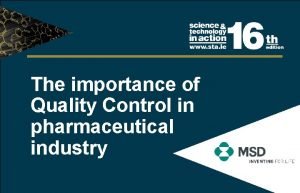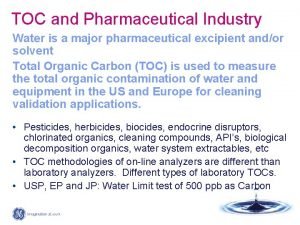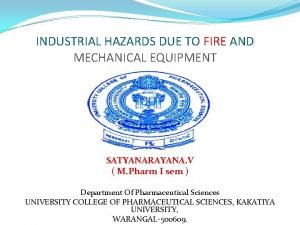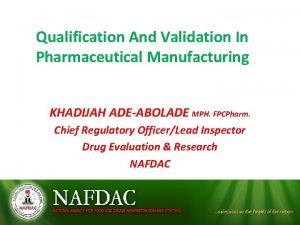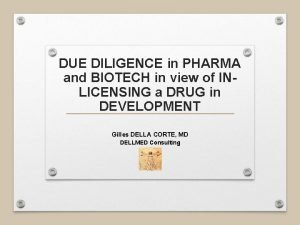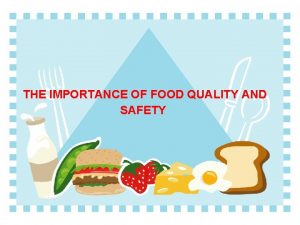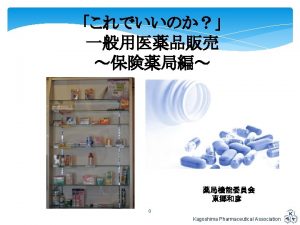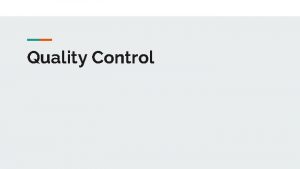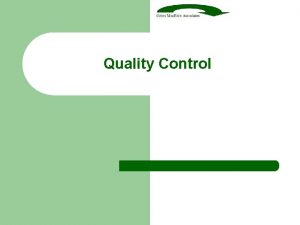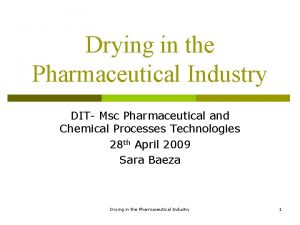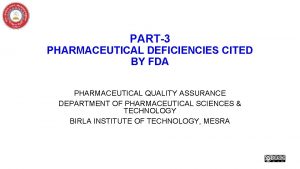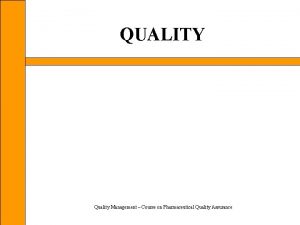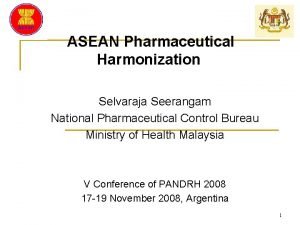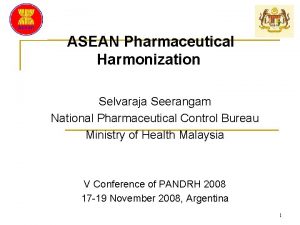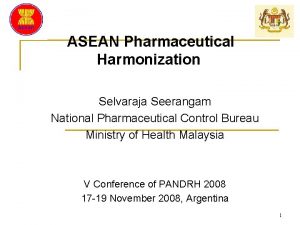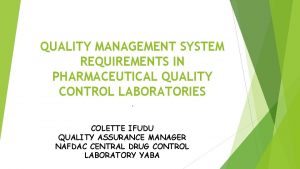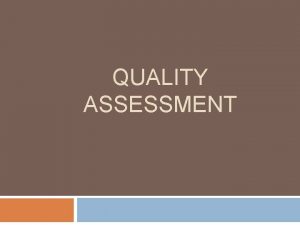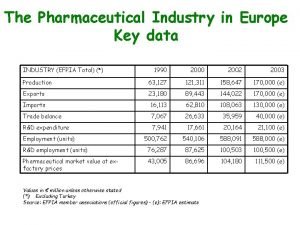The importance of Quality Control in pharmaceutical industry





















- Slides: 21

The importance of Quality Control in pharmaceutical industry

Topics l l l l l What does the ‘quality’ of a pharmaceutical product mean? Can you measure quality? Quality by Design — not just by testing Implementing Quality by Design The role of analysis in Quality Control Qualitative analysis Quantitative analysis Sampling and statistical analysis Product purity – an example Product potency

What does the ‘quality’ of a pharmaceutical product mean? l l l A high quality pharmaceutical product is one that is both safe and effective. It should therefore be of consistent composition and be free of unwanted by-products and contaminants. Medical practitioners and consumers will then have confidence in the product and will be more likely to choose it.

l If the quality of a product drops: l l Patients’ health may be compromised. . The manufacturer’s reputation may be damaged. . . A high-quality pharmaceutical product benefits both the producer and the consumer. In the long term, quality costs less and is more beneficial to both companies and patients.

Can you measure quality? l l The quality of pharmaceutical products can be checked by regular testing of samples, to ensure they are up to the required standards. Random samples are taken from each batch of product and tested for composition, weight, packaging, labelling, etc.

Quality by Design — not just by testing l l It is not enough to rely solely on testing to maintain the quality of a product, i. e. ‘quality by testing’. Quality should be ‘built in’ to the whole manufacturing process and be based on a fundamental understanding of what happens at every stage, i. e. ‘quality by design’.

Implementing Quality by Design The main features of Quality by Design may be summarised in the following steps: l What do you want to produce? What should the product do or what characteristics should it have? l Define the criteria that the product must meet for each of its desired characteristics. These can be regarded as product quality attributes. l Design all the steps involved -- raw materials, the chemical and physical processes, sampling, testing, packaging, etc.


The role of analysis in Quality Control l l You may have carried out simple tests to show the presence of starch, sugar, vitamin C, etc. in various foods. Qualitative tests indicating that various fruits and vegetables contain vitamin C, do not tell you how much vitamin they contain or which foods have the most or the highest concentration; for that, quantitative tests are required. Modern pharmaceutical analysis involves a range of qualitative and quantitative methods. Qualitative methods determine precisely what substances are present in a product. Quantitative methods assess the concentration of the active ingredient.

Qualitative analysis l l In school you may have carried out a test for acid using litmus paper or a test for carbon dioxide by bubbling it through limewater. Blue litmus paper changes to red in an acid. Carbon dioxide makes limewater go cloudy. These are qualitative tests; they indicate the presence of some substance but do not tell you how much is present.

Quantitative analysis l l Quantitative tests involve some measurement of quantities such as mass, volume, concentration, etc. Titrations that are carried out in school chemistry classes are examples of quantitative analysis. The classical quantitative methods of analysis include titration, precipitation, filtering and weighing. Burette Conical flask

Modern analysis l l Modern analysis includes methods and equipment such as mass spectrometry, chromatography, electrophoresis and several kinds of spectroscopy. In contrast to the classical methods, instrumental methods typically require expensive equipment as well as expertise in its use.

Sampling and statistical analysis l l Throughout the whole process of pharmaceutical manufacture samples are taken out for inspection and analysis. All samples from a particular step will not yield exactly the same result; there will always be slight variation in the quantities and in the measurements. Statistical analysis is applied to see if the variations are within the expected range. Since the mathematical formulae used in statistical analysis are valid only for random data, it is vital that the samples are taken randomly.

Product purity – an example l l The active ingredient in Tylenol tablets is paracetamol. Tylenol tablets are produced in a range of ‘strengths’, i. e. containing different amounts of paracetamol for different age groups: 80 mg, 160 mg, 325 mg, 500 mg. It is clearly important that the tablets or capsules contain the correct amount of the active and inactive ingredients and that they are labelled accordingly.

l l Inactive ingredients – called excipients – are commonly added to tablets to give them bulk and to bind and stabilise them. They also facilitate detection of counterfeit products. All the ingredients, both active and inactive, must be of very high purity and be free of harmful contaminants and allergens.

Product potency l l While the purity of a pharmaceutical product can be measured objectively, its potency is more difficult to measure. Potency of a product may be defined as the concentration or amount needed to produce the desired effect.

Potency l l If a pain relief tablet ‘cures’ a headache, would half a tablet be 50% effective? Potency can be measured by ELISA (Enzyme Linked Immunosorbent Assay) and other biological assays. The effectiveness is likely to vary from person to person.

Double blind trials l l l Double blind trials are used to determine statistically what amount of the product (as distinct from the placebo) has the desired effect on 50% of those who received it. In this way the potency can be estimated more objectively and the results allow comparisons to be made with other products or formulations. In double blind trials neither the ‘doctor’ nor the ‘patient’ knows if a placebo has been used instead of the active substance.

Student activity 1 l l Find the mass of 10 similar coins, one by one using an electronic balance. Assuming that the accuracy of the last digit is +/- 1, calculate the percentage range of the possible errors in each case. Then weigh all ten coins together and calculate the possible percentage range of error. Which is more accurate and why?

Student activity 2 l l The following online video introduces the Deming Cycle: https: //www. youtube. com/watc h? v=e 4 g. OPe. HSRo 8 Find out more about this cycle and summarise your findings in five slides.

Student activity 3 l l Quality Assurance focusses on the quality of the manufacturing process while Quality Control focusses on quality of the product. Discuss the importance of these areas for the future of Irish biopharmachemical industry. The following report should help: https: //dbei. gov. ie/en/Publications/Publicationfiles/Future-Skills-Needs-of-the-Biopharma-Industry-in -Ireland. pdf
 Importance of quality in pharmaceutical industry
Importance of quality in pharmaceutical industry Quality control and quality assurance
Quality control and quality assurance Plan quality management pmp
Plan quality management pmp Pmbok quality management
Pmbok quality management Basic concepts of quality assurance
Basic concepts of quality assurance Toc in pharmaceutical industry
Toc in pharmaceutical industry Good manufacturing practices in pharmaceutical industry
Good manufacturing practices in pharmaceutical industry Mechanical hazards in pharmaceutical industry
Mechanical hazards in pharmaceutical industry Customer satisfaction in pharmaceutical industry
Customer satisfaction in pharmaceutical industry Concurrent validation in pharmaceutical industry
Concurrent validation in pharmaceutical industry Enterprise risk management pharmaceutical industry
Enterprise risk management pharmaceutical industry Rutgers pharmd fellowship
Rutgers pharmd fellowship Biotech due diligence
Biotech due diligence Fraud in pharmaceutical industry
Fraud in pharmaceutical industry Definition of pharmaceutical inorganic chemistry
Definition of pharmaceutical inorganic chemistry Subimitted
Subimitted Importance of communication in service industry
Importance of communication in service industry Tqm exemplary organization
Tqm exemplary organization Importance of quality food
Importance of quality food Importance of quality
Importance of quality Importance of quality
Importance of quality Importance of quality
Importance of quality
